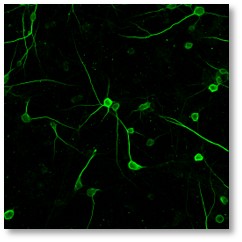The accumulation of misfolded proteins in the lumen of the Endoplasmic Reticulum activates an Unfolded Protein Response (UPR), through which an attempt is made to restore homeostasis. One of its initial responses is the reduction in protein synthesis, led by PERK (PKR-like ER kinase), a membrane protein kinase of the ER. If the damage is too extensive or becomes chronic, a cell death response is triggered. In other words, the UPR itself is paradoxical as it involves both the activation of protective and pro-apoptotic pathways.
It is well accepted that the decrease in Ca2+ in the organelle lumen triggers Endoplasmic Reticulum Stress. We discovered that once in the cytosol, Ca2+ acts as a cofactor, activating the cytoprotective phase of the Unfolded Protein Response (Bollo et al. 2010 Plos One, 5(8): e11925, Paredes et al. 2013, Cell Calcium 53:286). Particularly, we have observed, in astrocytes, a Ca2+-dependent protective role played by calcineurin (CN) and PERK. Furthermore, we demonstrated that the activation of this pathway strongly correlates with an increase in astrogliosis after inducing focal cerebral ischemia (Chen Y et al. 2016, Neurobiol Dis 94: 139).
We have described a mechanism of Ca2+ release through the translocon once Endoplasmic Reticulum stress is induced, and it has been confirmed that this signal amplifies the activation of PERK (Feliziani C et al. 2022, Cell Calcium 106: 102622) (Figure 1).
Figure 1: Global calcium increases following addition of high concentration of the stressor tunicamycin. Measurement of cytosolic Ca2+ changes by confocal imaging of cultured human astrocytes expressing Ca2+ indicator GCaMP6-Cytb5.
We have also demonstrated that modulation of PERK signaling alters the vulnerability of neurons to undergo neuritic atrophy and apoptosis in a cellular model of GM2-gangliosidosis (Virgolini M. J. et al., 2019, Biochim Biophys Acta Mol Cell Res. 1866(2): 225). Recently, we have discovered that an endogenous bile acid, UDCA, holds potential therapeutic promise as it has proven effective in reducing neuritic atrophy in this cellular model (Morales C. et al., 2023, International Journal of Molecular Sciences, 24(8):7209) (Figure 2)
 Figure 2: UDCA reduces neuritic atrophy induced by the accumulation of the complex lipid GM2.
Figure 2: UDCA reduces neuritic atrophy induced by the accumulation of the complex lipid GM2.
COMPETITIVE RESEARCH FUNDS
- PICT- 2019-I-A (# 2019-00155). “Modulation of Calcineurin on PERK during acute phase of Endoplasmic Reticulum stress”. PI.
- NIH, AG058778-01A1, Agreement UTHSCSA-Institute Ferreyra No 165148/165147. “Regulation of ER-stress activated UPR kinase PERK in neurodegenerative disease”. PI in Argentina.
PUBLICATIONS (LATEST FIVE YEARS)
Morales C, Fernandez M, Ferrer R, Raimunda D, Carrer DC, Bollo M. Ursodeoxycholic Acid Binds PERK and Ameliorates Neurite Atrophy in a Cellular Model of GM2 Gangliosidosis. (2023) International Journal of Molecular Sciences.; 24(8):7209. ISSN: 2076-6327.
Feliziani C., Fernandez, M, Quasollo G., Holstein D., Bairo, M., Paton J.C., Paton A.W., de Batista J., Lechleiter J.D. and Bollo M. Ca2+ signalling system initiated by Endoplasmic reticulum stress stimulates PERK activation. (2022) Cell Calcium 106: 102622, ISSN: 0143-4160.
Morales C., Bisbal M. and Bollo M. Molecular modulation by lentivirus-delivered specific shRNAs in endoplasmic reticulum stressed neurons. (2021) J Vis Exp, ISSN: 1940-087X. (170). doi: 10.3791/61974.
Cabrera Zapata L.E., Bollo M and Cambiasso MJ. Estradiol-mediated axogenesis of hypothalamic Neurons requires ERK1/2 and Ryanodine Receptor dependent intracelular Ca2+ rise in male rats. (2019) Front Cell Neurosci 13:122. ISSN- 1662-5102.
Virgolini MJ, Feliziani C, Cambiasso MJ, Lopez PHH and Bollo M. Neurite atrophy and apoptosis mediated by PERK signaling after accumulation of GM2-ganglioside. (2019) Biochim Biophys Acta Mol Cell Res. 1866(2): 225-239. Editorial: Elseiver, Amsterdam, Holanda ISSN-0167-4889.
- Complete and updated list available here.
TEAM









